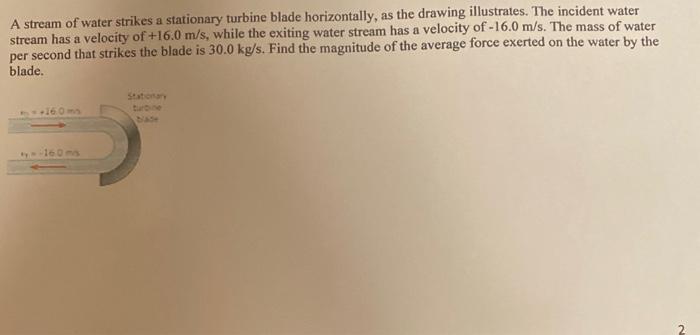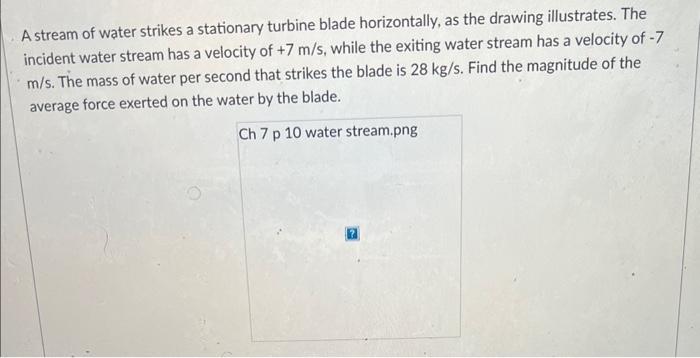A stream of water strikes a stationary turbine, setting in motion a captivating journey into the realm of hydroelectric power generation. This enthralling narrative delves into the intricate workings of turbines, the conversion of water energy into electricity, and the environmental considerations surrounding this renewable energy source.
From the fundamentals of turbine design to the intricacies of water flow and impact, this exploration unveils the scientific principles that govern the efficient harnessing of water’s energy. Prepare to be captivated as we embark on a comprehensive examination of a stream of water’s transformative encounter with a stationary turbine.
Hydroelectric Power Generation: A Stream Of Water Strikes A Stationary Turbine
Hydroelectric power generation harnesses the energy of flowing water to produce electricity. It is a clean and renewable energy source that plays a significant role in global electricity production.
Components of a Hydroelectric Power Plant
- Reservoir: Stores water to create a head of water.
- Dam: Regulates water flow and creates the head of water.
- Intake: Directs water into the penstock.
- Penstock: A pipe that carries water to the turbine.
- Turbine: Converts the energy of flowing water into mechanical energy.
- Generator: Converts mechanical energy from the turbine into electrical energy.
- Transformer: Increases the voltage of the electricity for transmission.
Factors Affecting Hydroelectric Power Generation Efficiency
- Head of water: The higher the head of water, the greater the potential energy available for conversion.
- Water flow rate: The greater the water flow rate, the more energy can be extracted.
- Turbine efficiency: The efficiency of the turbine in converting water energy into mechanical energy.
- Generator efficiency: The efficiency of the generator in converting mechanical energy into electrical energy.
Turbine Design and Operation

Types of Turbines Used in Hydroelectric Power Plants
- Pelton turbines: Used for high head and low flow applications.
- Francis turbines: Used for medium head and medium flow applications.
- Kaplan turbines: Used for low head and high flow applications.
Principles of Turbine Operation
Turbines operate on the principle of momentum exchange. As water flows through the turbine blades, it imparts its momentum to the blades, causing them to rotate. This rotation is then used to drive the generator.
Factors Influencing Turbine Selection and Design
- Head of water
- Water flow rate
- Turbine efficiency
- Cost
Water Flow and Impact

Impact of Water Flow Rate and Velocity on Turbine Performance
The water flow rate and velocity directly influence the power output of a turbine. Higher flow rates and velocities result in increased power output.
Relationship between Water Pressure and Turbine Efficiency
Water pressure is directly related to the head of water. Higher water pressure leads to increased turbine efficiency and power output.
Effects of Cavitation and Other Fluid Dynamics on Turbine Operation
Cavitation occurs when the water pressure drops below its vapor pressure, causing the formation of vapor bubbles. These bubbles can damage turbine blades and reduce efficiency.
Energy Conversion and Transmission
Converting Mechanical Energy from the Turbine into Electrical Energy
The generator converts the mechanical energy from the turbine into electrical energy through electromagnetic induction. As the turbine rotates, it induces an electric current in the generator’s stator windings.
Role of Generators and Transformers in the Energy Conversion Process
Generators produce electricity at low voltage. Transformers increase the voltage for efficient transmission over long distances.
Transmission of Electricity from the Power Plant to Consumers, A stream of water strikes a stationary turbine
Electricity is transmitted from the power plant to consumers through a network of power lines and substations.
Environmental Considerations

Environmental Impact of Hydroelectric Power Generation
- Alteration of river ecosystems
- Displacement of wildlife
- Greenhouse gas emissions from reservoirs
Mitigation Measures Used to Minimize Environmental Impacts
- Fish ladders and bypass channels
- Wildlife relocation programs
- Methane capture and utilization
Role of Hydroelectric Power in Sustainable Energy Systems
Hydroelectric power plays a crucial role in sustainable energy systems by providing clean and renewable electricity. It can help reduce greenhouse gas emissions and contribute to energy security.
FAQ Corner
What is the efficiency range of hydroelectric turbines?
Hydroelectric turbines typically achieve efficiencies between 85% and 95%, making them highly efficient energy converters.
How does cavitation affect turbine performance?
Cavitation occurs when the water pressure around the turbine blades drops below its vapor pressure, causing the formation of vapor bubbles. These bubbles can collapse violently, damaging the turbine blades and reducing efficiency.
What environmental impacts are associated with hydroelectric power generation?
Hydroelectric dams can disrupt fish migration, alter river ecosystems, and contribute to greenhouse gas emissions during reservoir creation.